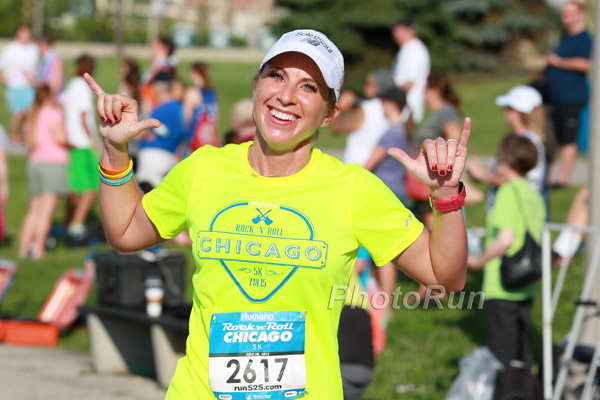A Hilly Topic: The Boston Marathon Course
Dear Friends,
Many of you who have run the Boston Marathon before probably can describe in vivid detail every hill, whether it be “rolling,” “steep” or “tricky.” And, of course, it is likely you fondly remember the nice flat running sections as well. I am thinking of you passionate athletes who have tackled the course—run each spring on Patriots’ Day—and of Dick and Rick Hoyt, the legendary father-and-son, runner-and-wheelchair duo who have run the race together an amazing 32 times! For our first timers, you might appreciate our shared reassurance that, with some good planning and a proper race strategy, you will find the course spectacular and fun to run.
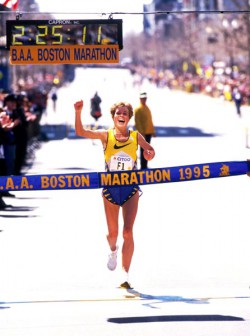
I have such fond memories of Race Day: the wonderful spring scents of brisk mornings in Hopkinton, the winding country roads during the early parts of the course, the rolling hills throughout, the spirited cheers of the Wellesley College women (be prepared to feel some magic there) and, finally, the home stretch into town, with Boston’s skyline heralding the approach to the Finish Line. I will never forget the stunning atmosphere, the caring people who love this race so much, and, of course, the enthusiastic and knowledgeable New England crowds who pack Boylston Street ten deep to welcome the runners. And our Boston Marathon is now more loved than ever before.
What is it about this marathon course…
…that dominates runners’ conversations each April? Why are some of us voicing concerns about being able to include enough special hill workouts? And why are others of us thinking, “…Am I running too much hilly terrain during my workouts at the expense of the speedwork I need in my training?”
Before going into details about the course, I would like to share one important thought. Even though the Boston Marathon course is known for its rolling hills and challenging uphill and downhill sections, there are many flat parts and rather gentle downhill parts as well. Many of these sections are quite comfortable to run. With this in mind, the best approach for running Boston is to stay relaxed within your own unique stride and cadence. This is because the course requires a good running technique to handle the frequent alternation of “uphill and downhill running” segments.
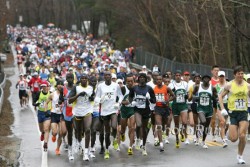
Now, I would like to share with you some details of the course in Boston and give you a few ideas about preparing for it during the remaining weeks of training. Many runners I have coached for the Boston Marathon had some interesting questions—for example, the best technique for downhill running, how to prepare for the course during the last weeks leading up to the event, and, of course, race strategy. Thanks to my collaboration with those wonderful runners and my own experiences preparing for seven Boston marathons in the 1990’s, I have had the chance to become quite familiar with the terrain.
And while there are many more details to consider, here are some I believe are key to running successfully in Boston. Those of you who previously have run this marathon most likely remember them very well ;-).
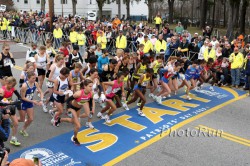
Hopkinton is a beautiful town and a very generous host to us runners each Patriots’ Day. It is “where it all starts.” The Boston Athletic Association (“B.A.A.”) does a tremendous job guaranteeing a smooth start for all participants—always overcoming the challenge of the relatively narrow starting area. It is a good place to be careful and patient as it can be pretty crowded until the field thins out. The first 4 ½ miles descend from Hopkinton into Ashland, with the first mile being the steepest—dropping 130 ft. It actually can be the trickiest part of the course because many runners tend to start the marathon too fast. It feels like “easy running.” But, please, do not fall victim to this temptation. If you do, you may find yourself tiring much earlier in the race than anticipated. The most deceptive parts of the Boston course are the downhill sections, especially this one.
Start smooth and stay relaxed, resisting the temptation to run fast downhill to “gain time”—a common misjudgment. With a good and smooth downhill running technique and focusing on staying within your average speed for your marathon for the first 5 miles, you will be able to avoid having to deal with later problems, like fatigued quads.
As you enter Framingham at roughly 5 miles, you can enjoy a stretch of several miles of mainly flat segments with some small and gentle rolling hills. It is a great part of the course to find a good running rhythm. Perhaps you may also get the chance to join a buddy or a group of fellow runners for a while to help you stay on your timing schedule. As it is best for the entire race, break this distance into several shorter pieces—and only focus on getting from one point to another. One example would be to set a goal of getting from one water stop to the next.
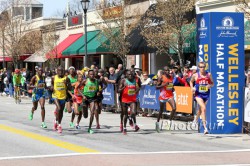
By 10 miles you will be two miles into Natick, and running over a few rolling hills until the 13-mile mark in Wellesley. This is a great time to start looking forward to the storm of cheers and encouragement that will greet you from the many enthusiastic students of Wellesley College. This legendary “Screech Tunnel,” as it is called, will inspire you and might help you forget the first little fatigue you may be feeling. Enjoy and absorb the energy of the loving crowd, it can help carry you through the next part of the marathon.
The now more-gentle rolling hills continue until you have run a little over 15 ½ miles. The next section—not quite a mile long—is one of my favorite stretches of the course (and can be an interesting strategic point in the elite athletes’ competitions). It gives you a great opportunity to shake off some fatigue as you enjoy running on this nice gentle downhill to the 16 ½ mile. More importantly, you can use this section to mentally prepare yourself to enter Newton and its famous hills.
First your will run on four rather rolling hills—a frequent alternation of up and downhill running—which I hope you can master with enough reserves to be able to tackle the last three hills. They are known as the three Newton Hills—with the most famous being “Heartbreak Hill.”
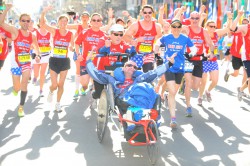
At roughly 17 ½ miles, a right turn at the Newton Fire Station will signal that you are approaching these last three hills. “Heartbreak” is the last one, covering roughly 0.4 mile between Mile 20 and Mile 21. If you feel very strong, attack them a little bit—or even a little bit more ;-).
If you are already a bit tired at this point, make friends with those hills. Continue to run smart by taking smaller steps uphill, using good deep-breathing and keeping as relaxed a running style as possible. Focus only on one hill at a time, and relax on the downhill part to regain momentum. And it might help you to know that a long gentle downhill section is awaiting you.
Why does this “Heartbreak Hill” have to be so scary? I looked at it with respect and with a positive and happy focus—a challenge—and once jokingly nicknamed it “Bunny Hill,” which helped me give it some perspective and gave me a sense of being stronger than the hill, especially after training at 5,600 to more than 8,000 ft. altitudes, including very steep hills in the Colorado Rockies. And happily, first-time Boston runners often tell me that they did not find “Heartbreak Hill” difficult at all, thanks to a good race strategy and preparation.

Finally, the long gentle downhill stretch! It starts a little after 21 miles and by the 22-mile mark the course will have dropped about 80 ft. as you enter Boston. The famous CITGO sign points the way to downtown. It is another of my favorite parts. From Mile 22 to Mile 25, the course will not drop as much as during the previous mile but it still is a nice gentle downhill stretch which, hopefully, you can use to run home safely. Please remember to keep drinking some fluid—enough to stay hydrated—because, in all the excitement, it is easy to forget.
A short distance outside Kenmore Square, before the 25-mile marker, there is a slight ascent as a bridge crosses over the Mass Turnpike. On the other side of the bridge, you can enjoy the downhill run—and shortly afterwards thousands of supportive fans will greet you in Kenmore Square.

You are so close now. Just 1 mile to go! At this point you are on Commonwealth Avenue. You will run through a small tunnel beneath Massachusetts Avenue (see the picture next to this paragraph). Shortly after that you will turn right into Hereford Street and run up the very last hill. It is a small short slope, but it can feel a little daunting so close to the finish, so maybe you can check it out during the days before the marathon—it is right by the Boston Fire Station. Oh, I hope you can ignore that feeling of fatigue as much as possible, and use little steps to get up that hill.
And after you have turned left onto Boylston Street, you can enjoy the homestretch to the finish. As you approach, then cross the Finish Line, you will be overwhelmed by the appreciation, cheers, and congratulations of the most wonderful marathon crowd in the world!
How to Prepare for the Rolling Hills During Your Remaining Training
- Get familiar with the course. This will be a huge advantage. The key is to be mentally and physically prepared for the ongoing alternations of downhill and uphill sections, and understanding the dynamics of the first part of the course, especially the first 4 to 5 miles. It also is an advantage to get to know the rolling hills in the middle part, culminating in the Newton Hills. Finally, be mentally prepared by knowing the layout of the last two miles of the marathon before you cross the bridge over the Mass Turnpike through to the finish. Some of you trained on the marathon course a few times and if you have a chance to do this, it can be a great asset in preparing for Boston.
- Be friends with the course. It is best that instead of attacking the course, you “run within it.” That means that, from the start, you allow yourself to “run with” these alternating uphill and downhill sections by staying in a relaxed running style and using a good running technique. Also, by focusing on staying relaxed as much as you can and not “fighting” the course, you will enable yourself to run faster.
- As already mentioned, please avoid starting out too fast! Even though the course drops quickly in the first mile, run smoothly and not too fast. You will dictate the entire outcome of your marathon within the first few miles. So, please avoid being too aggressive in the beginning even if you feel good.
- Practicing good downhill and uphill running techniques will best prepare you to manage the course and run well in Boston. Mastering the downhill running technique is, in my experience, even slightly more important than the uphill technique due to the trickier downhill sections. Of course, you will need to rely on both techniques a lot. Please find below some focus points for both techniques.
- Stick to rather rolling hills at this point of your marathon preparation, since it is best to stay in a “smooth” running rhythm. If you are able to do so, make it a habit to take the hills aggressively all the way to the top, then “let go” and run downhill in a more relaxed mode. Too steep of an uphill and/or downhill will not be as efficient. It also can create a risk of injury at this point. Please adjust all the information above for your own level of fitness.
- For our beginning marathoners: add to your uphill training a few easy downhill strides to prepare for the downhill sections of the course as well. You can do these strides after one or two of your easy and shorter runs of the week.
- For our intermediate and advanced marathoners: add to your uphill intervals some short downhill runs after one of your easy and short running sessions. I always did them after an easy run a day before my interval workout of the week. It proved to be another helpful tool for running well on the hilly Boston Marathon course. Choose a distance of up to 100 meters, repeat 5 to 8 times—stronger runners can repeat up to 12 times—and jog up as recovery in between each fast repeat.
A Few Focus Points for Your Downhill and Uphill Running Technique

Downhill Running: Train to run controlled by keeping your body straight and your shoulders relaxed. Downhill running requires a very clean technique—stay relaxed with less effort and higher cadence and keep control of your stride. Avoid pounding down the hill with steps that are too long. Run smoothly with less muscle tension and with a slightly shorter and faster but still relaxed step.
You can check your downhill running technique, preferably during your easy runs or while training with some easy downhill strides. After a few “rehearsals,” you will find yourself able to incorporate a good technique in all your runs.
If you are still relatively new to downhill running, only include a few gentle and smaller hills at this stage of your marathon preparation, not just to avoid adding too much stress on feet, knees, and hip, but also to keep a relaxed running rhythm.
Uphill Running: This is the easier running technique compared to downhill running. Concentrate on leaning slightly forward depending on the degree of incline of the hill. A steeper hill means leaning slightly more forward. Focus on small steps—shorter ones compared to running on flat ground or running downhill. Keep your body weight on the ball of your feet. You will push up from this foot position right under your hips, driving off your back leg.
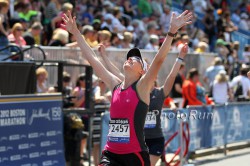
In summary for both techniques: Tackle the hills with a relaxed mind… and shorter steps. Keep your smooth running rhythm and have a slight forward-leaning body position while going uphill. Due to the smaller steps, it might feel almost like “rushing up a small hill to quickly see what’s beyond it.” I hope you can try out these recommendations and focus on your downhill and uphill running technique. Rather than overwhelming you, I hope it can be just like play. Focus on taking small steps on the uphill sections and keeping a smooth and relaxed running style on the downhill parts with steps that are not too long.
And the Newton Hills? Yes, they are waiting for us—but in spite of all you might have heard about them YOU will be prepared!
I wish you all the best for your remaining training, and, of course, for a fantastic marathon experience.
Keep running,

Reading Suggestions:
- Tapering: Maximizing the Remaining Weeks of Training Before Your Marathon
- Training Advice for the Second Build-Up Period for Your Marathon Preparation
The author won Boston in 1994, ’95, ’96.
Updated March 27, 2019
Updated March 2, 2017
Updated February 25, 2016
Updated March 6, 2015
- Posted June 6, 2015
© Copyright 2013-2022 by Uta Pippig and Take The Magic Step®. All Rights Reserved.
More Insights
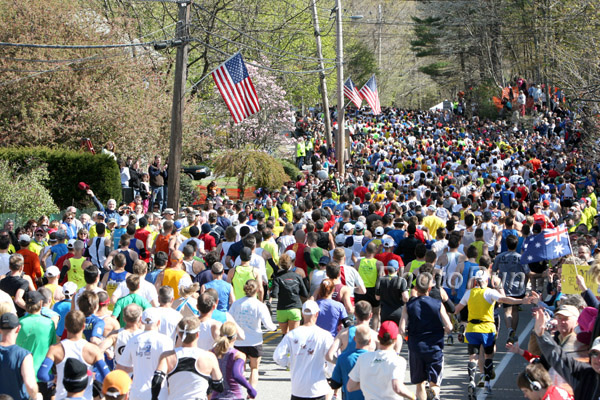
A Hilly Topic: The Boston Marathon Course
The most effective approach for tackling the Boston Marathon course is to stay relaxed within your own unique stride and cadence. The frequent alternation of uphill, downhill, and flat sections will tempt you to break from your pre-race strategy, but stay with your plan.
Uta’s Favorite Exercises to Improve Your Fitness and Running Technique
Uta Pippig has designed an at-home fitness program which only uses your own body weight, steps, and a Theraband. They are eight exercises that Uta often does herself.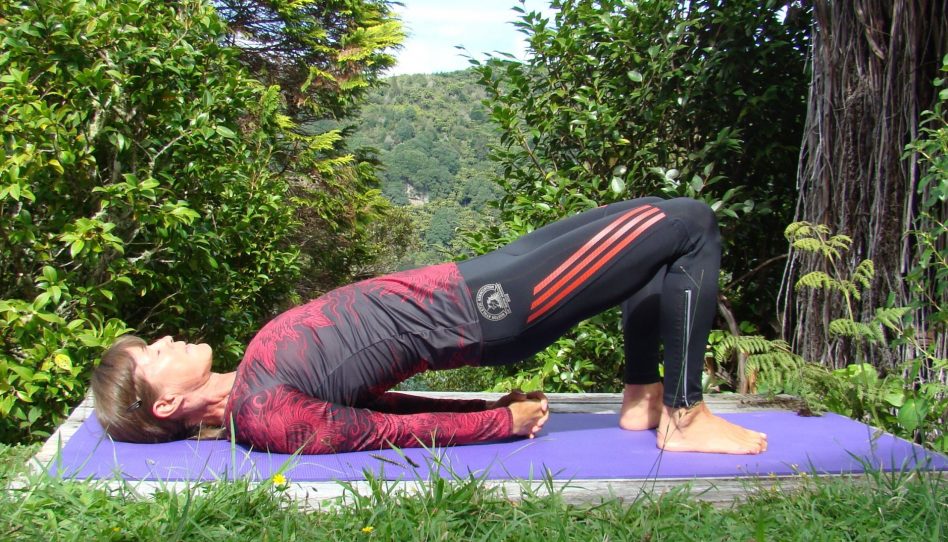
Uta’s Yoga and Stabilization Guide for a Better Running Technique
Runners, especially, can benefit from a well-balanced yoga and stabilization program. Uta suggests effective combinations of poses and exercises that have helped her gain the flexibility and balance that can lead to a better running technique for everyone.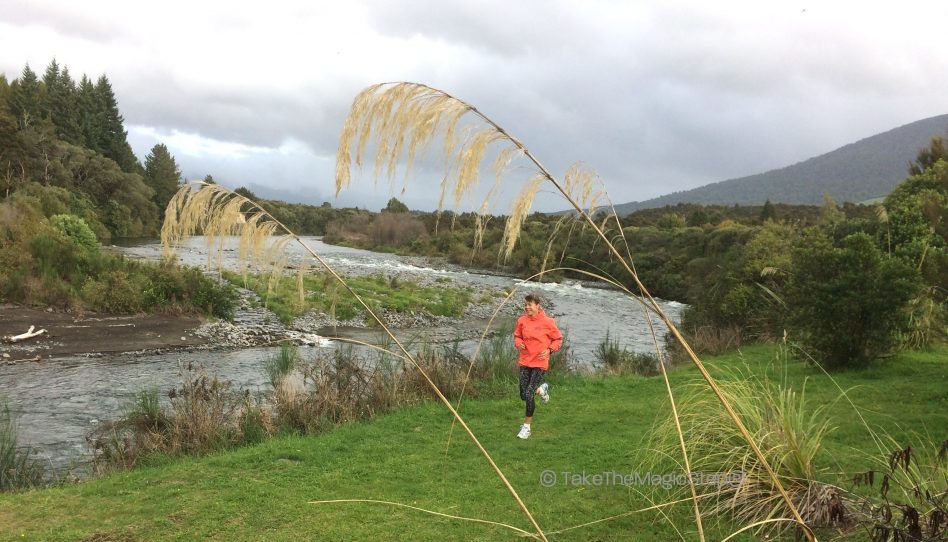
How a Clever Mental Focus Can Get You Through Running Injuries
Running injuries can be devastating, but learning to focus mentally can speed up the healing process. Uta explains how the forced break from running can actually provide future benefits.